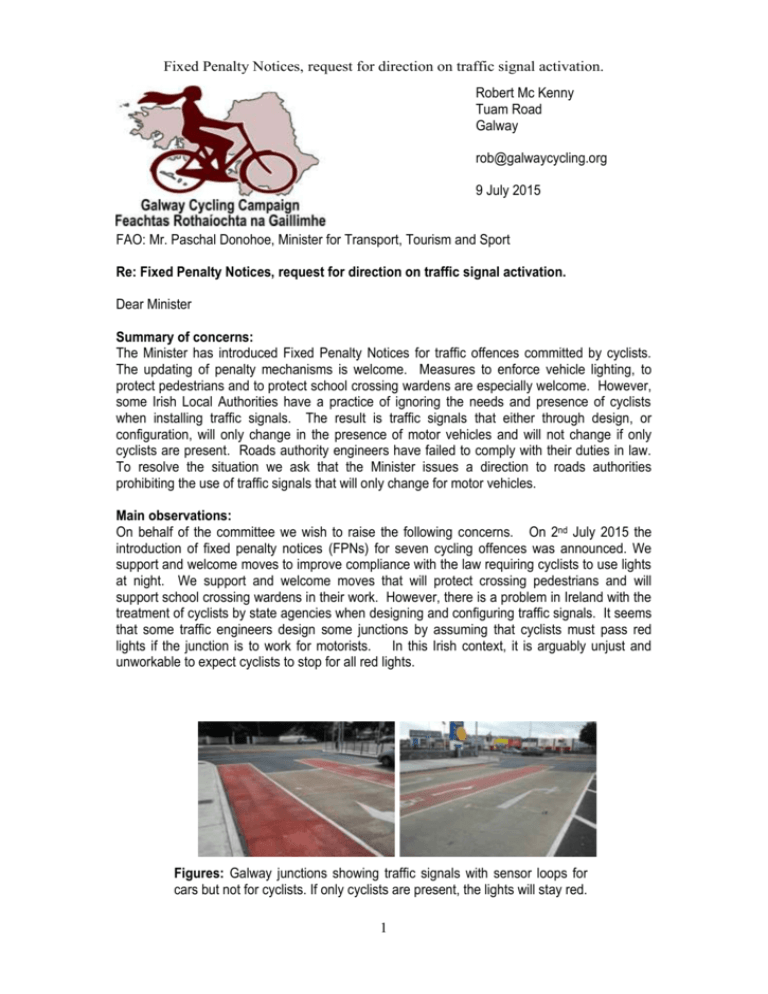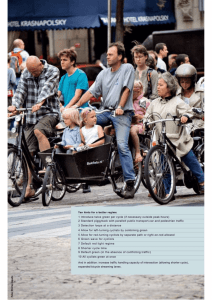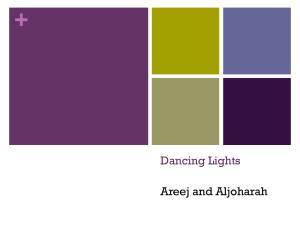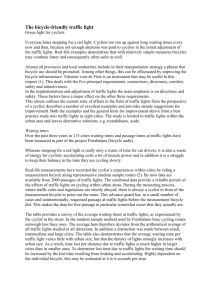Fixed Penalty Notices Letter to Paschal Donohue
advertisement

Fixed Penalty Notices, request for direction on traffic signal activation. Robert Mc Kenny Tuam Road Galway Address rob@galwaycycling.org 9 July 2015 FAO: Mr. Paschal Donohoe, Minister for Transport, Tourism and Sport Re: Fixed Penalty Notices, request for direction on traffic signal activation. Dear Minister Summary of concerns: The Minister has introduced Fixed Penalty Notices for traffic offences committed by cyclists. The updating of penalty mechanisms is welcome. Measures to enforce vehicle lighting, to protect pedestrians and to protect school crossing wardens are especially welcome. However, some Irish Local Authorities have a practice of ignoring the needs and presence of cyclists when installing traffic signals. The result is traffic signals that either through design, or configuration, will only change in the presence of motor vehicles and will not change if only cyclists are present. Roads authority engineers have failed to comply with their duties in law. To resolve the situation we ask that the Minister issues a direction to roads authorities prohibiting the use of traffic signals that will only change for motor vehicles. Main observations: On behalf of the committee we wish to raise the following concerns. On 2nd July 2015 the introduction of fixed penalty notices (FPNs) for seven cycling offences was announced. We support and welcome moves to improve compliance with the law requiring cyclists to use lights at night. We support and welcome moves that will protect crossing pedestrians and will support school crossing wardens in their work. However, there is a problem in Ireland with the treatment of cyclists by state agencies when designing and configuring traffic signals. It seems that some traffic engineers design some junctions by assuming that cyclists must pass red lights if the junction is to work for motorists. In this Irish context, it is arguably unjust and unworkable to expect cyclists to stop for all red lights. Figures: Galway junctions showing traffic signals with sensor loops for cars but not for cyclists. If only cyclists are present, the lights will stay red. 1 Fixed Penalty Notices, request for direction on traffic signal activation. In Ireland, there has been move away from traffic lights that use timers to change the lights, to systems that use detectors (or both). These systems mainly use sensors made from a rectangular loop of wire buried in the road near the stop lines – this can detect metal objects entering the loop. The detectors can be set up to detect some bicycles. Irish cyclists have found cases where Irish traffic light detectors do not detect bikes, and as a result, the traffic lights will not change for cyclists. An example in Galway is at the junction of Fr Griffin Avenue and Fr. Griffin Rd. A cyclist stopped at the stop line waiting to enter Fr Griffin Rd. will occupy the sensor loop. In that case what will happen is that the lights will stay red and a queue of cars will build up behind the cyclist along Fr Griffin Avenue. The only way to get the lights to change is for the cyclist to pull forward of the stop line, which is technically an offence, and beckon a car from behind into the sensor loop. This junction is configured so that cyclists must “run the light” if it is to work for cars. There are similar examples at junctions that have cycle tracks. There will be sensors in the “car” lanes, but no sensor system for cyclists in the cycle tracks. At junctions with “Advanced Stop Lines” or “Bike Boxes” it is not unusual to find that there is no sensor system associated with the bike box. In these situations, although cycle “facilities” have been “provided”, it seems the designers don’t intend that the lights should work for cyclists unless a car happens to come along and trigger the detector. We would argue that in effect, several generations of Irish roads engineers have been “training” Irish cyclists to ignore red traffic lights. Figures: Galway, junction at NUI, Galway showing traffic signals with bike box and cycle track before the red overlay was applied. The main lanes have sensor loops for cars but cycle track and bike box have no sensors for cyclists. The buried wires cross the cycle track but there is only a rectangular sensor loop for motor vehicles. Proposed solution It is clearly desirable that cyclists should obey the relevant traffic regulations; however cyclists do not exist in a vacuum. Article 13.5 of the 1993 Roads Act states “In the performance of their functions [..] a road authority shall consider the needs of all road users.” 2 Fixed Penalty Notices, request for direction on traffic signal activation. Some roads authorities have failed to comply with the spirit of law in the manner in which they manage traffic signals. In that context, applying FPNs to cyclists regarding red lights becomes problematic since in some cases the junction design apparently assumes they must break the law. If greater compliance among cyclists is the aim then it is not enough to apply penalties for red light running, cyclists must be given some assurance that traffic lights will actually work for them. Proper design rather than enforcement is the best solution to red light running. It seems to us that there is a solution which would result in fairness and greater compliance with the law by both roads authority engineers and by cyclists. Under Article 15 of the Roads Act you have the power to issue directions to roads authorities. “15.—(1) The Minister may give a direction in writing to a road authority in relation to any of the functions assigned to it by or under any enactment (including this Act) relating to the maintenance or construction of public roads and the road authority shall comply with such direction.” Our proposed solution is that you as Minister issue a direction that the use of traffic signals that only change for cars must cease. If roads authorities were required to use timers for all lights, or more appropriate sensor systems, then that would make the system fair for all. This direction would not prevent roads authorities from using sensors to detect queues and adjusting the timing of the lights on different arms on the basis of demand. There is a wider issue that at some junctions, there is no apparent traffic management justification for applying traffic signals to cyclists. The classic example is where cyclists are turning left from a side road onto a main road where there is a cycle facility on the main road they are joining. Other countries address this by providing bypass arrangements or a legal permission to pass red lights in defined circumstances. This is a wider issue that might be best addressed under the proposed review of the National Cycle Policy Framework. Yours sincerely, Robert Mc Kenny Chair Galway Cycling Campaign 3






